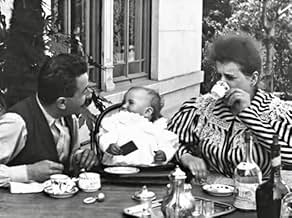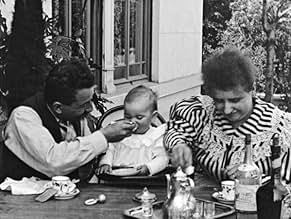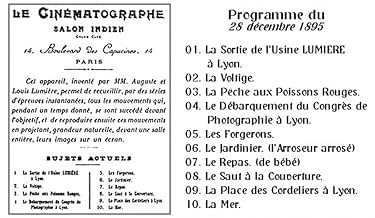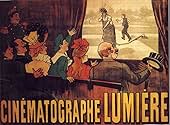PUNTUACIÓN EN IMDb
5,9/10
3,7 mil
TU PUNTUACIÓN
En el marco de una primera proyección pública en el Salon Indien, el 28 de diciembre, en París, Auguste Lumière hace girar el centro de atención en torno a su hija pequeña, mientras intenta ... Leer todoEn el marco de una primera proyección pública en el Salon Indien, el 28 de diciembre, en París, Auguste Lumière hace girar el centro de atención en torno a su hija pequeña, mientras intenta alimentarla con una cuchara.En el marco de una primera proyección pública en el Salon Indien, el 28 de diciembre, en París, Auguste Lumière hace girar el centro de atención en torno a su hija pequeña, mientras intenta alimentarla con una cuchara.
- Dirección
- Reparto principal
Reseñas destacadas
Repas de bebe (1895)
This early film from Louis Lumiere is pretty simple as a mom and dad are facing the camera with their child sitting between them. They feed the baby. Yep, that's all that happens in this early film but it's a pretty interesting experiment. Of course, this was 1895 so it's silly to try and compare this film to the film's of today. Things were so early at this point that people like Lumiere were just filming whatever they could. If you've got children then this here will obviously appeal to you as it's quite funny to see the baby's reaction to all this food coming its way.
This early film from Louis Lumiere is pretty simple as a mom and dad are facing the camera with their child sitting between them. They feed the baby. Yep, that's all that happens in this early film but it's a pretty interesting experiment. Of course, this was 1895 so it's silly to try and compare this film to the film's of today. Things were so early at this point that people like Lumiere were just filming whatever they could. If you've got children then this here will obviously appeal to you as it's quite funny to see the baby's reaction to all this food coming its way.
The pleasant domestic scene in this early Lumière feature is nicely photographed, and it essentially allows the viewer to share in a peaceful moment with a family from a long-past era. It has fortunately been preserved in excellent condition, so that the detail and composition can be appreciated.
This is one of many very early moving pictures that showed how much more a movie could do than a still photograph. As simple and calm as all of the actions are in this feature, they bring the scene to life, making it feel less like an event from the distant past, and more like a short visit with living beings. Whether by chance or by design, the swaying leaves in the background which are caught quite clearly add an extra dose of realism.
As a result of all of these things, the outdoor setting is convincing, and the simple scene is an endearing one that is worth watching.
This is one of many very early moving pictures that showed how much more a movie could do than a still photograph. As simple and calm as all of the actions are in this feature, they bring the scene to life, making it feel less like an event from the distant past, and more like a short visit with living beings. Whether by chance or by design, the swaying leaves in the background which are caught quite clearly add an extra dose of realism.
As a result of all of these things, the outdoor setting is convincing, and the simple scene is an endearing one that is worth watching.
Two loving parents feed their happy baby on the perch of their country home. It is often said that these early Lumiere shorts are primitive because they have not yet mastered basic film grammar, such as camera movement, editing or the close-up, films like these being a simple, static set-u;, the camera pointing at the scene from a middle distance. But as filmmakers like Godard, Ozu and Kitano, for instance, realised, that very grammar can be a violation of the integrity of the image, forcing us to concentrate of the structure in which the image is only a unit, rather than the image itself.
There is nothing primitive or simple about this particular image; as critics have noted, this film offers two levels of movement, one human, recognisable, communal (the family); the other (the trees blowing) part of a different order altogether, of nature, cycles, immemoriality. So while the family represents a similar idea of continuity as the trees, of the species being reproduced, it sis also offered in stark contraast to them, as each member of the trio will eventually die, for all the nourishment and fertility, while nature lives on, indifferent.
This frisson of mortality undercuts the film's essential conservatism, and differentiates it from the sinister surveillance of the earlier 'Sortie d'Usine'. This recognition that the powers of the camera-wielding Lumieres are in fact limited, that they are not as omniscient as they once thought they were, is perhaps dramatised in the figure of the father, one of the brothers, one of the first great director-stars, paving the way for Chaplin, Keaton and Welles. His crossing the line from director to star, from passive to active, from subject to object, represents a breach between the observer and observed, a breaking of that invisible line, a destruction of that contract Hollywood will try so desperately to enforce, between reality and fiction. The watcher is now the watched, distinctions and hierarchies have been abolished.
Ironically, immortality has been conversely guarenteed - while the man behind the camera is lost, fading into a mere eye, a role taken over by every viewer, the actor brother is trapped forever in this rigid, simple domestic scenario, feeding the ever-hungry, unthinking baby, a harbinger of the medium he invented.
There is nothing primitive or simple about this particular image; as critics have noted, this film offers two levels of movement, one human, recognisable, communal (the family); the other (the trees blowing) part of a different order altogether, of nature, cycles, immemoriality. So while the family represents a similar idea of continuity as the trees, of the species being reproduced, it sis also offered in stark contraast to them, as each member of the trio will eventually die, for all the nourishment and fertility, while nature lives on, indifferent.
This frisson of mortality undercuts the film's essential conservatism, and differentiates it from the sinister surveillance of the earlier 'Sortie d'Usine'. This recognition that the powers of the camera-wielding Lumieres are in fact limited, that they are not as omniscient as they once thought they were, is perhaps dramatised in the figure of the father, one of the brothers, one of the first great director-stars, paving the way for Chaplin, Keaton and Welles. His crossing the line from director to star, from passive to active, from subject to object, represents a breach between the observer and observed, a breaking of that invisible line, a destruction of that contract Hollywood will try so desperately to enforce, between reality and fiction. The watcher is now the watched, distinctions and hierarchies have been abolished.
Ironically, immortality has been conversely guarenteed - while the man behind the camera is lost, fading into a mere eye, a role taken over by every viewer, the actor brother is trapped forever in this rigid, simple domestic scenario, feeding the ever-hungry, unthinking baby, a harbinger of the medium he invented.
Repas de Bebe was one of the films on the bill of the Lumiere brothers' first exhibition of motion pictures for a paying audience. The basement room of the Hotel Salon Indien the brothers hired for the occasion was half-empty on the first ever cinema screening - but the second night was a sell-out. Of course, by today's standards most of the film's appear quite crude and this one is no great shakes but it does capture a tender family moment as Auguste Lumiere and his wife feed their baby son. It's a shot that's been repeated millions of times since by anyone who ever had a family and owned a cine camera/video camera or mobile phone, and as such there's a certain poignancy to it.
Louis Lumiere's brother, Auguste, and his wife sit at a table, in their garden, feeding their child - who sits between them. Shrubbery in the background rustles indicating a slight breeze. Perhaps the public, in 1896, would see this and wish they could preserve family scenes such as this for their posterity. Now, 107 years later, we can - on film or video. We have come a long way, baby!
¿Sabías que...?
- CuriosidadesFilm historians often jokingly refer to this film as the first 'home movie,' as it depicts the filmmaker's home life in a documentary fashion, without any attempt at narrative contrivances.
- ConexionesEdited into The Lumière Brothers' First Films (1996)
Selecciones populares
Inicia sesión para calificar y añadir a tu lista para recibir recomendaciones personalizadas
Detalles
- Duración1 minuto
- Color
- Mezcla de sonido
- Relación de aspecto
- 1.33 : 1
Contribuir a esta página
Sugerir un cambio o añadir el contenido que falta



















